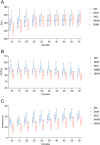Evaluation of different intramuscular injectable anesthetic combinations in rabbits: Impact on anesthetic depth, physiological parameters, and EEG recordings
- PMID: 39999112
- PMCID: PMC11856588
- DOI: 10.1371/journal.pone.0319106
Evaluation of different intramuscular injectable anesthetic combinations in rabbits: Impact on anesthetic depth, physiological parameters, and EEG recordings
Abstract
Rabbits have a high anesthesia-related mortality rate because of their small size, high metabolic rate and challenging airway management. This study aimed to investigate different combinations of intramuscularly administered anesthetics in New Zealand White rabbits, focusing on their effects on anesthetic depth, physiological parameters, and electroencephalogram (EEG) recordings. Defined doses ketamine (K), esketamine (SK), medetomidine (M), dexmedetomidine (D), midazolam (Mi), and butorphanol (B) were investigated and compared in five different combinations: KM (25/0.25 mg/kg), SKM (17/0.25 mg/kg), SKD (17/0.15 mg/kg), MMiB (0.25/1/0.2 mg/kg), and DMiB (0.15/1/0.2 mg/kg). For 60 minutes, the anesthetic depth was assessed using an anesthesia score, and physiological parameters, including heart rate (HR), respiratory rate (RR), oxygen saturation and blood pressure were recorded. The study also assessed the latencies to loss and recovery of reflexes after targeted antagonization, and EEGs were measured. The rabbits were not intubated and were supplied with oxygenated air via nasal probes. All anesthetic combinations achieved anesthesia with surgical tolerance, with significant intergroup differences in HR, RR, blood pressure and EEG power spectra. The KM group demonstrated the most stable anesthesia and rapid recovery, while SKD and SKM groups showed prolonged recovery times. Oxygen saturation remained consistently high across all groups, obviating the need for intubation. All rabbits recovered fully after anesthesia. In conclusion, intramuscular administered anesthetic combinations can provide effective anesthesia with surgical tolerance for short procedures in rabbits. Monitoring circulatory parameters during and after anesthesia and adequate pain management pre-, inter-, and postoperatively are essential. Considering these criteria, the KM group presented the best results compared with the other groups.
Copyright: © 2025 Schmid et al. This is an open access article distributed under the terms of the Creative Commons Attribution License, which permits unrestricted use, distribution, and reproduction in any medium, provided the original author and source are credited.
Conflict of interest statement
The authors have declared that no competing interests exist.
Figures






References
-
- Wenger S. Anestehsia and analgesia in rabbits and rodents. J Exot Pet Med. 2012;21:7–16. doi: 10.1053/j.jepm.2011.11.010 - DOI
MeSH terms
Substances
LinkOut - more resources
Full Text Sources
Medical

